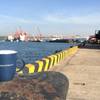“Swift” Passage Establishes Barrier Reef Speed
The distance is 488 n.m. pilot to pilot and on August 31 the Swift covered the distance in 12.5 hours at an average speed of 39.04 knots. The speed takes into account the period required to slow down to embark and disembark the pilot and once underway the transit was made at an actual speed of over 40 knots.
The transit was made using electronic charts and using Differential Global Positioning System (DGPS) available in the Great Barrier Reef courtesy of Australian Maritime Safety Authority shore stations.
The passage through the Reef also included the transit of the newly established Fairway Channel. The High Speed Vessel (HSV) HSV 2 Swift will serve operationally as an interim Mine Warfare Command and Support Ship (MCS), and support transformational mine warfare modular mission payload initiatives. In support of Navy experimentation, the HSV will be used to explore concepts, capabilities and military utility associated with the advanced hull and propulsion technology integrated with advanced communications in support of the Littoral Combat Ship (LCS) program.
For the Marine Corps, the HSV will conduct a series of limited-objective experiments, exercises, demonstrations and training events that develop interoperability potential of high-speed vessels with causeways, watercraft, amphibious ships and other shipping. Experimentation data will be used to access the military utility of HSVs and future joint and naval military operations or applications.
The HSV is capable of maintaining an average speed of 35 knots or greater, loaded with 500 short tons, consisting of 350 personnel and military equipment. A minimum operating range of 1,100 n.m.at 35 knots is required by the contract, as is a minimum transit range of 4,000 n.m. at an average speed of 20 knots. Furthermore, the vessel must be capable of 24-hour operations at slow speeds (3-10 knots) for experimentation with unmanned autonomous vehicles, and to support dedicated and emerging organic mine warfare missions.
With sea trials, Navy acceptance, and crew certification complete Swift will now deploy and commence routine operations. The vessel will operate with crews stationed at Naval Station Ingleside, Texas, and Naval Amphibious Base Little Creek, Va.














